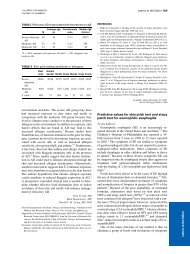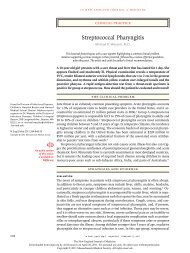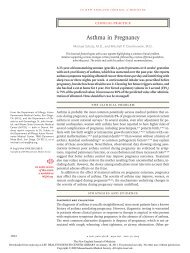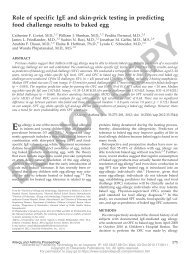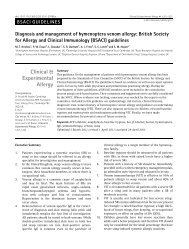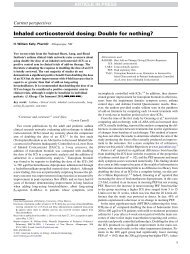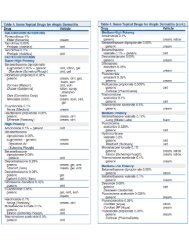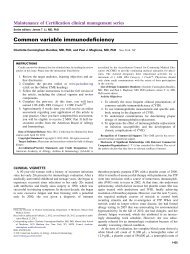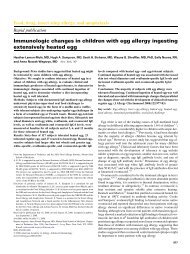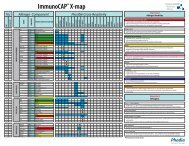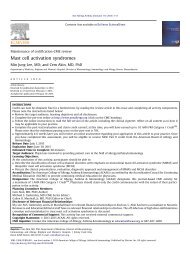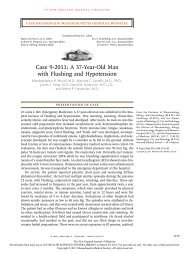Diagnosis and management of oral allergy syndrome ... - AInotes
Diagnosis and management of oral allergy syndrome ... - AInotes
Diagnosis and management of oral allergy syndrome ... - AInotes
Create successful ePaper yourself
Turn your PDF publications into a flip-book with our unique Google optimized e-Paper software.
individuals with a history <strong>of</strong> contact dermatitis in response to poison ivy<br />
[17,18]. Contact dermatitis <strong>of</strong> the lips involves painful swelling or blistering <strong>of</strong><br />
the lips, followed by peeling during resolution, which occurs over the course <strong>of</strong><br />
days. The presence <strong>of</strong> persistent skin lesions distinguishes these conditions<br />
from OAS.<br />
Gastroesophageal reflux disease (GERD) — Patients with GERD can usually be<br />
distinguished clinically by less prominent <strong>oral</strong> symptoms or objectively, by the<br />
absence <strong>of</strong> sensitization to the food or related pollen in question. (See "Clinical<br />
manifestations <strong>and</strong> diagnosis <strong>of</strong> gastroesophageal reflux in adults".)<br />
Eosinophilic esophagitis (EE) — EE can sometimes present with the sensation<br />
<strong>of</strong> food becoming lodged in the throat <strong>and</strong> may mimic PFAS <strong>and</strong> other forms <strong>of</strong><br />
food <strong>allergy</strong>. Evaluation <strong>of</strong> dysphagia is discussed in detail elsewhere. (See<br />
"Evaluation <strong>of</strong> dysphagia in adults".)<br />
FUTURE DIAGNOSTIC TESTS — Tests using recombinant allergens are being<br />
developed, which could determine more precisely the allergens to which a patient is<br />
sensitized. In theory, these tests could distinguish individuals sensitized to labile<br />
antigens, such as Bet v 1 homologs or pr<strong>of</strong>ilins, from those sensitized to heat <strong>and</strong><br />
digestion-resistant antigens, <strong>and</strong> thus differentiate between PFAS <strong>and</strong> primary plant<br />
food <strong>allergy</strong>. (See "Future diagnostic tools for food <strong>allergy</strong>" <strong>and</strong> "Pathogenesis <strong>of</strong><br />
<strong>oral</strong> <strong>allergy</strong> <strong>syndrome</strong> (pollen-food <strong>allergy</strong> <strong>syndrome</strong>)".)<br />
Component-resolved diagnostics — Component Resolved Diagnostics (CRD)<br />
detects IgE sensitization to the individual allergens (components) in the complex<br />
food. This technology represents a new direction in food <strong>allergy</strong> diagnosis. CRD<br />
may be especially helpful in distinguishing between cross-reactive allergens <strong>and</strong><br />
primary sensitizing allergens, <strong>and</strong> in defining the risk for systemic <strong>and</strong>/or severe<br />
reactions in patients with plant food <strong>allergy</strong>. CRD is commercially available in<br />
Europe <strong>and</strong> Japan; it is being evaluated by the FDA in the US. (See "Future<br />
diagnostic tools for food <strong>allergy</strong>", section on 'Technological advances'.)<br />
When individual allergens are known, they can be purified from natural sources or<br />
obtained via recombinant methods [19-21]. These individual allergens may be used<br />
for skin testing <strong>and</strong> for IgE immunoassays [22]. ImmunoCAP ISAC® (Immuno<br />
Solid-phase Allergen Chip, Phadia) uses protein microarray chip technology to test<br />
a panel <strong>of</strong> 103 individual components from more than 47 plant <strong>and</strong> non-plant foods<br />
<strong>and</strong> environmental allergens from about 500 mcl blood sample obtained by<br />
fingerstick [23]. ISAC yields a tremendous amount <strong>of</strong> information that further<br />
increases the sophistication <strong>and</strong> complexity <strong>of</strong> pollen food <strong>allergy</strong> diagnosis.<br />
Accordingly, ISAC requires careful interpretation [22].<br />
CRD results still have to be validated with <strong>oral</strong> food challenges to establish the



